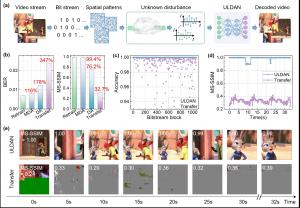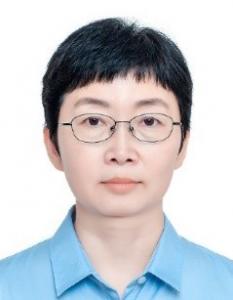Unsupervised Cross-Domain Adaptation | Single-Pixel Image Transmission in Unknown Dynamic Channels
Figure 1: Single-pixel Imaging Information Transmission Framework based on Unsupervised Learning Domain Adaptive Networks.
Recent advancements leveraging deep learning (DL) have significantly improved SPI performance, especially at low compression ratios.
CHENGDU, SICHUAN, CHINA, October 6, 2025 /EINPresswire.com/ -- Imaging technologies are ubiquitous in our daily lives, from smartphone cameras to medical imaging devices, helping us capture images and perceive objects. However, when faced with complex environments, such as haze, thick clouds, or tissues inside the human body, traditional imaging technologies often struggle. In these environments, light is easily scattered, leading to blurred images. This is akin to trying to hear distant sounds during a storm, external interference challenges the accuracy and stability of imaging.Single-pixel imaging technology, as an efficient method for imaging through scattering media, combines structured light illumination with compressed sensing algorithms, enabling it to operate with an extremely simplified detection system. Only a basic one-dimensional signal detector is required, alongside a set of specially designed "optical masks" to modulate the target scene. This allows for the reconstruction of clear images from minimal data. It can be compared to observing from a single lens at different angles and piecing together the perspectives to recreate a complete image. This technology significantly enhances the sensitivity of imaging, making it particularly effective in complex environments.
However, despite the excellent performance of single-pixel imaging in many fields, it still faces a challenge: how to accurately reconstruct images from limited data. The current mainstream single-pixel imaging methods typically rely on neural networks or physical models to precisely characterize channel conditions. Yet, when the channel undergoes dynamic changes and its transmission characteristics cannot be directly measured, the performance of existing imaging transmission schemes significantly deteriorates. Achieving precise image transmission in dynamic and unstable scattering media environments remains an urgent issue to be addressed. This research seeks to address these challenges, aiming to enhance the accuracy and efficiency of image reconstruction in difficult conditions, which will be critical for advancing imaging technology in real-world applications.
The research group of Prof. Nan Chi from the college of Future Information Technology at Fudan University propose a single-pixel imaging framework for information transmission based on unsupervised learning domain adaptation networks. This framework achieves feature alignment of sensor-acquired signals from different domains using adversarial learning, and reuses a source domain's pre-trained feature decoding module to reconstruct images in the target domain. As a result, high-quality unsupervised image transmission is achieved even under complex and unknown dynamic channels, as illustrated in Figure 1. The work, titled "Unsupervised learning enabled label-free single-pixel imaging for resilient information transmission through unknown dynamic scattering media," is published in Opto-Electronic Advances in 2025 in early view section.
The introduction of deep learning technologies in recent years has provided new approaches for high-quality single-pixel image transmission in complex channels, making reliable information transfer in a wide range of complex scenarios feasible. However, most existing single-pixel imaging technologies focus on specific channel conditions, and when faced with unknown dynamic environments (such as varying signal attenuation or changing lighting conditions), deep learning models pre-trained in the source domain often perform poorly in the target domain. To address this issue, the research team decomposes the image reconstruction process in single-pixel imaging into two stages: encoding and decoding. By leveraging adversarial learning, they map single-pixel detection signals under varying channel conditions to a shared feature space, enabling feature alignment across different data distributions. This method allows the decoder module from the source domain to be reused in the target domain, leading to high-quality, unsupervised image reconstruction in the target domain.
Experimental results show that when the compression ratio is below 0.2, the proposed method achieves high-fidelity image transmission with structural similarity exceeding 0.9 in various complex turbulent channels. In practical underwater dynamic turbulent channels over a 5-meter distance, the proposed method improved the signal-to-noise ratio (SNR) of USAF target imaging by more than 13 dB compared to traditional methods. Moreover, the approach successfully demonstrated near-lossless transmission of 720×720 resolution color video in an underwater dynamic turbulent channel, validating its super-high precision for long-range information transmission through dynamic scattering media.
This research effectively addresses the dependence on large labeled training datasets in end-to-end supervised learning methods for single-pixel imaging tasks through unsupervised learning-based domain adaptation techniques, while significantly enhancing image quality and transmission efficiency. The proposed framework paves the way for reliable information transmission in unknown and dynamically changing environments, offering a novel paradigm for overcoming "fog" and "mist" challenges. It holds great potential for a wide range of applications in fields such as biomedical imaging, marine exploration, and autonomous driving.
About the Author:
Nan Chi, Professor at Fudan University, Ph.D. supervisor, recipient of the National Outstanding Young Scientist Fund, and Fellow of the Optical Society of America. She serves as a committee member of the Optical Communication Subcommittee of the China Communications Society, Vice Chairman of the Underwater Communication Branch, Vice Chairman of the Communications Branch, and Vice Chairman of the Circuits and Systems Branch of the China Electronics Society. She has long been engaged in research on high-speed visible light communication. With over 400 published papers, more than 15,000 Google citations, and an H-index of 60, she has authored 10 monographs. She has published four monographs related to high-speed optical communication, including works under national key publishing programs such as the "14th Five-Year National Key Publishing Program," "Key Books of the 13th Five-Year Plan for National Strategic Equipment," and "Fudan University's 100 High-Quality Textbooks." She has been ranked among the "Top 2% Global Scientists" for three consecutive years and recognized as an "Elsevier Highly Cited Scholar in China" for four consecutive years. She has received several honors, including the First Prize of Natural Science from the China Communications Society, the First Prize of Scientific and Technological Progress from Henan Province, and the First Prize of Scientific and Technological Progress from the Chinese Society of Optical Engineering.
Read the full article here: www.oejournal.org/oea/article/doi/10.29026/oea.2025.250013
Andrew Smith
Charlesworth
+44 7753 374162
marketing@charlesworth-group.com
Visit us on social media:
LinkedIn
YouTube
Other
Legal Disclaimer:
EIN Presswire provides this news content "as is" without warranty of any kind. We do not accept any responsibility or liability for the accuracy, content, images, videos, licenses, completeness, legality, or reliability of the information contained in this article. If you have any complaints or copyright issues related to this article, kindly contact the author above.


